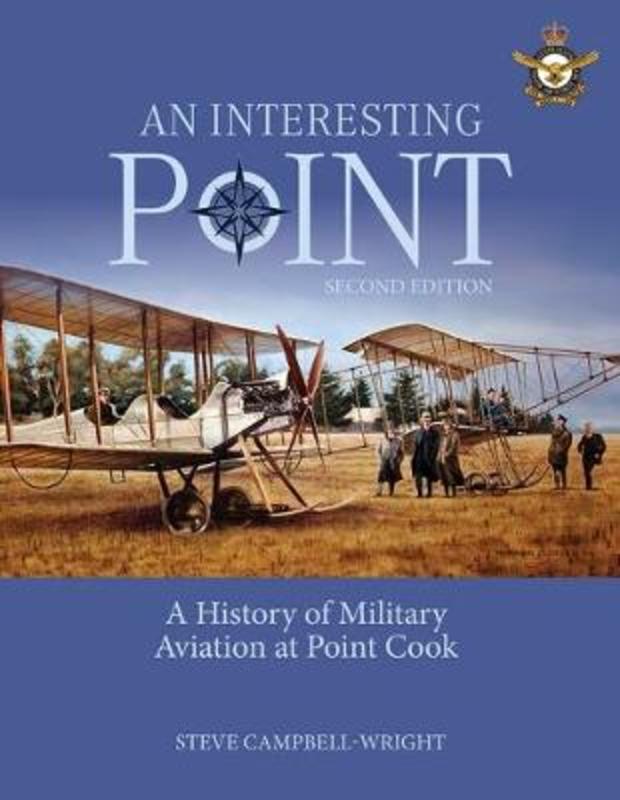On Sunday, 1 March 1914, a Bristol Boxkite aircraft flown by Lieutenant Eric Harrison, took to the skies over Point Cook, Victoria, marking the first flight by a military aircraft in Australia. It was the beginning of Australia’s long and distinguished military aviation capability.

Big Sky Publishing: Newport, NSW; 2nd edition, 2019; 244 pp; ISBN 9781922265722
(hard cover); RRP $29.99
The first edition of An Interesting Point: A History of Military Aviation at Point Cook, was published in 2014 to mark the centenary of military aviation in Australia. It sold out. This second edition has been prepared to provide a lead-in to celebrations marking the Royal Australian Air Force’s centenary in 2021. It updates the 2014 edition’s concluding chapter and makes some minor corrections.
The author, Steve Campbell-Wright, served in the Royal Australian Air Force (RAAF) for over 35 years. He holds a doctor of philosophy degree in arts from the University of Melbourne and postgraduate qualifications in cultural heritage from Deakin University. He has written on subjects as diverse as heritage homes of the Australian Defence Force and Australia’s motoring heritage. His recreational interests include rebuilding historical aircraft. He skilfully weaves a history spanning a century that gives a glimpse into the often-secretive world behind the
gates of the birthplace of military aviation. He blends the history and development of Point Cook with that of the Australian Flying Corps from 1914 to 1918 and the RAAF from 1921. While describing the development of the Base buildings and infrastructure that became historical heritage, his portrayal of the people who took the decisions, implemented plans and conducted operations from Point Cook brings a compelling human touch to the history
In an historical account of the establishment and development of Point Cook, it is difficult not to address the history of the RAAF also. He has done this with great skill, describing the broad history of the Service without overlooking the detail of life at Point Cook. Despite its success and pivotal role in the early development of the Australian Flying Corps, the efforts to get these pilots into the air stumbled because of government bureaucratic delays, including the delayed purchase of Point Cook and its designation as a military airfield. Overcoming a painful gestation, Point Cook developed into the centrepiece for the early Air Force with a life that reflected the challenges and triumphs of the Air Force in a golden period in peacetime and a demanding period of world war.
In early years, the development and continued existence of the Air Force was directly attributable to the vision and drive of Wing Commander Richard Williams, the father of the Air Force – from the selection of uniforms, training regimes, setting of standards, public relations with a community that knew little of aviation, to the political infighting to avert the efforts of the Army and Navy to absorb the Air Force into their own Services. The situation no doubt was exacerbated by a reputation of Point Cook being a gentlemen’s flying club arising from the “sensational aspects of exuberant aircrew” in the 1920s. Point Cook, however, became the epicentre for the establishment, development and mastery of the technical and engineering expertise essential for the successful conduct of future aviation operations. As the RAAF’s primary operational establishment, it had a significant role in the establishment of national and international air routes; sponsored the development of civil aviation within the community; and hosted the Royal Victorian Aero Club before its move to Moorabbin Airport. It was the home of the Australian National Airlines Commission Training School, training pilots, aircraft mechanics, ground engineers and hostesses for the
newly-formed Trans Australian Airlines.
Status as the RAAF’s primary operational establishment was eclipsed during World War II with the development of a myriad of other training schools. Nevertheless, Point Cook supported the Empire Air Training Scheme graduating almost 3000 pilots and over 7000 signalers. Towards the turn of the century, economic rationalisation, recession and expenditure on Middle Eastern wars threatened the continued existence of Point Cook as a military base. In line with its past, however, it survived and is now the home for various Air Force units as well as the RAAF Museum, which holds a trove of treasures from Point Cook’s past.
An Interesting Point is well researched, well written and easy to read. It easily maintains the reader’s interest throughout. It is very well presented and supported with beautiful photographs that bring the history to life. Of necessity, photographs of the early life of Point Cook are black and white; however, they are of high quality and are amply supported with excellent colour plates of the more recent history of the Base.
The book will appeal to those who have at least a passing interest in aviation history. Point Cook is the ancestral home of the RAAF and the site for the first military flight in Australia. To quote a former Chief of Defence Force and Chief of Air Force, Air Chief Marshal Sir Angus Houston: The history of Point Cook is an important story. It is one which should be better known to all Australians.
Reviewed for RUSINSW by Bob Treloar
Contact MHHV Friend about this article.






